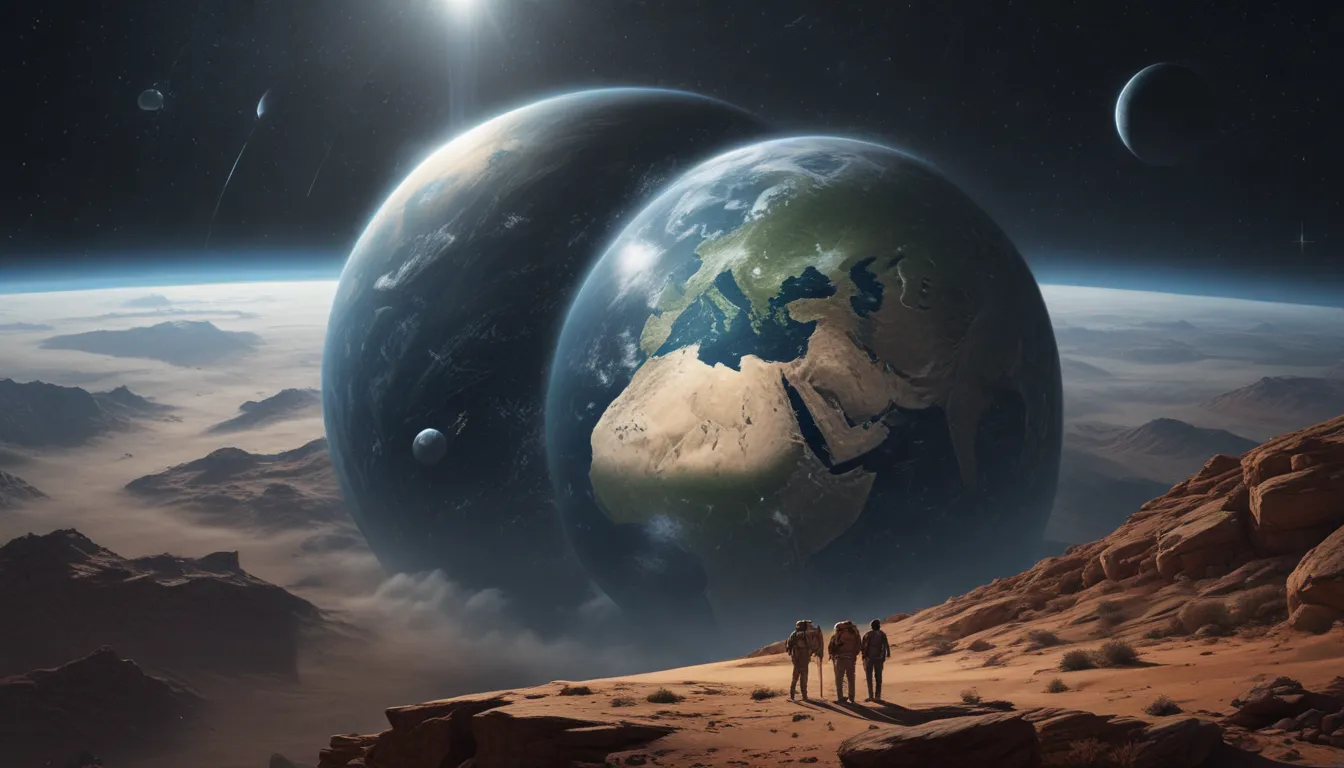The pictures we use in our articles might not show exactly what the words say. We choose these pictures to make you interested in reading more. The pictures work together with the words but don’t take their place. The words still tell you the important facts.
Welcome to the realm of spaceborne Earth observation, where cutting-edge technology unlocks the secrets of our planet and beyond. From unraveling climate change mysteries to aiding in disaster management, satellites provide a bird's eye view of Earth, revolutionizing scientific exploration. Join us as we uncover 19 extraordinary facts about spaceborne Earth observation that will leave you spellbound by the wonders of our universe.
Unveiling the World from Above
Spaceborne Earth observation offers a unique perspective on our planet, capturing stunning images and data from satellites orbiting high above. By surveying Earth's land, oceans, atmosphere, and weather patterns, these satellites provide a comprehensive view of our planet like never before.
The Sky’s Watchful Guardians
With over 2,000 satellites actively orbiting Earth for Earth observation purposes, these technological marvels are equipped with advanced sensors and instruments to capture high-resolution images and gather critical data. They act as Earth's vigilant guardians, monitoring everything from climate change to disaster management with unwavering precision.
The Marvelous Applications of Spaceborne Observation
Monitoring Climate Change
Spaceborne Earth observation plays a pivotal role in monitoring and studying climate change. By collecting data on temperature fluctuations, ice melt, deforestation, and other indicators, satellites provide scientists with essential information to understand the effects of climate change on our planet.
Mapping Earth’s Land and Water Resources
From tracking changes in vegetation to monitoring urban growth, spaceborne Earth observation aids in mapping Earth's land and water resources. Scientific advancements allow for the identification of fluctuations in water bodies, movement of glaciers, and even desert transformations through satellite imagery.
Disaster Management Support
In times of natural disasters, satellites for Earth observation are indispensable. By offering real-time information on earthquakes, hurricanes, wildfires, and other calamities, these satellites enable swift and efficient response measures, saving lives and mitigating damage.
Agricultural and Crop Monitoring
By capturing detailed images of agricultural areas, spaceborne Earth observation assists in monitoring crops, identifying crop health issues, and predicting yields. This data empowers farmers to make informed decisions, optimize irrigation practices, and effectively manage pests and diseases.
Biodiversity Protection
Spaceborne Earth observation aids in monitoring and protecting biodiversity by tracking changes in habitats, deforestation rates, and wildlife populations. This invaluable information supports conservation efforts and promotes sustainable practices to safeguard our planet's rich ecosystem.
Empowering Scientific Discoveries
Accurate Weather Forecasting
Spaceborne Earth observation plays a significant role in providing essential data for accurate weather forecasting. By capturing information on atmospheric conditions, cloud cover, and temperature patterns, satellites empower meteorologists to predict weather events and issue timely warnings to communities at risk.
Enhanced Ocean Monitoring
Through satellites, spaceborne Earth observation enables continuous monitoring of our oceans. It allows for tracking ocean currents, sea surface temperatures, and phenomena like El Niño, contributing to a deeper understanding of marine ecosystems and their intricate dynamics.
Urban Planning and Development Insights
Spaceborne Earth observation offers invaluable data for urban planning and development initiatives. By analyzing data on urban sprawl, infrastructure changes, and environmental impacts of human activities, satellite imagery supports informed decision-making in sustainable urban development.
Disaster Recovery Assistance
In the aftermath of natural disasters, spaceborne Earth observation plays a vital role in assessing damage and facilitating recovery efforts. Satellite imagery aids in identifying areas requiring urgent assistance, guiding relief operations, and accelerating the restoration of affected regions.
Harnessing the Power of Technology
Supporting Geological Exploration
Spaceborne Earth observation provides crucial data for geological exploration, offering insights into natural resources, mineral deposits, and geological formations. This information is essential for conducting resource assessments and planning mining operations with precision.
Monitoring Air Quality
By tracking pollution levels and identifying sources of pollution, spaceborne Earth observation plays a pivotal role in monitoring air quality. This data helps in understanding the impact of human activities on air quality and developing strategies for pollution control.
Deforestation Tracking
Satellite imagery enables spaceborne Earth observation to track deforestation rates and illegal logging activities. By monitoring changes in forest cover, conservation efforts can be enhanced, leading to effective protection of forests and preservation of biodiversity.
Glacier and Ice Sheet Monitoring
Spaceborne Earth observation contributes significantly to monitoring changes in glacier and ice sheet mass. Satellite data on ice melt rates aids in understanding the impact of climate change on polar regions and global sea levels, providing valuable insights for climate scientists.
Volcanic Activity Monitoring
Through satellite imagery analysis, scientists can monitor volcanic activity and identify potential eruptions. This critical information supports volcano monitoring agencies in issuing timely warnings to safeguard vulnerable populations and minimize the impact of volcanic events.
Enriching Environmental Research and Conservation Efforts
Facilitating Sea Level Changes Tracking
Satellites used for Earth observation play a crucial role in monitoring sea level changes. This data aids scientists in understanding the effects of global warming and predicting the potential consequences for coastal areas, contributing to climate change research and coastal management strategies.
Providing Data for Global Land Cover Mapping
Spaceborne Earth observation facilitates global land cover mapping by capturing high-resolution images of Earth's surface. This data is instrumental in understanding land use patterns, urbanization trends, and the impact of human activities on the environment, guiding sustainable land management practices.
Embracing a Future of Innovation and Exploration
In conclusion, spaceborne Earth observation stands as a beacon of discovery, unlocking unprecedented insights into our planet and shaping diverse fields of scientific inquiry. From climate monitoring to disaster management, satellite technology continues to redefine our understanding of Earth's processes and environments. As advancements in remote sensing techniques propel this field forward, the possibilities for environmental science, agriculture, urban planning, and beyond are limitless. By harnessing the power of spaceborne observation, we embark on a journey of discovery that promises to unveil even more extraordinary facts and solutions for a sustainable future.
Frequently Asked Questions
-
What is spaceborne Earth observation?
Spaceborne Earth observation involves using satellites and other space-based platforms to gather information about Earth's surface, atmosphere, and related aspects. It encompasses capturing images, collecting data, and monitoring environmental and climatic phenomena from space. -
How does spaceborne Earth observation contribute to understanding climate change?
Spaceborne Earth observation provides crucial data on Earth's climate system, including temperature variations, atmospheric composition, and changes in ice cover and vegetation. These observations aid scientists in monitoring climate trends, identifying drivers of climate change, and developing accurate climate models. -
What are the applications of spaceborne Earth observation?
Spaceborne Earth observation has diverse applications, including environmental monitoring, disaster management, agriculture, urban planning, and natural resource management. It is utilized for tracking deforestation, crop health monitoring, detecting natural disasters, and providing essential data for land-use planning. -
What types of satellites are used for Earth observation?
Various types of satellites are employed for Earth observation, such as polar-orbiting satellites, geostationary satellites, and hyperspectral satellites. Each type offers specific capabilities and orbits, enabling varied observation strategies and resolutions. -
How is spaceborne Earth observation data collected and analyzed?
Spaceborne Earth observation data is collected by satellites equipped with sensors that capture images and measure physical properties of Earth. These data are transmitted back to Earth for rigorous analysis and processing, extracting meaningful information using specialized software and algorithms.
Spaceborne Earth observation invites us to explore the wonders of our planet and beyond, ushering in a new era of discovery and innovation. Embrace the limitless possibilities of satellite technology and remote sensing as we continue our quest to understand and protect the beauty of our world. Join us in this voyage of exploration and knowledge, as we unveil the extraordinary facts and marvels of spaceborne Earth observation.






